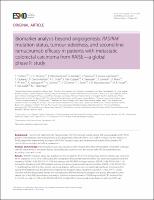| dc.contributor | Vall d'Hebron Barcelona Hospital Campus |
| dc.contributor.author | Yoshino, T. |
| dc.contributor.author | Portnoy, D. C. |
| dc.contributor.author | Obermannova, Radka |
| dc.contributor.author | Bodoky, György |
| dc.contributor.author | Prausová, J. |
| dc.contributor.author | Tabernero Caturla, Josep |
| dc.contributor.author | Garcia-Carbonero, Rocio |
| dc.date.accessioned | 2021-03-19T12:39:55Z |
| dc.date.available | 2021-03-19T12:39:55Z |
| dc.date.copyright | 2018 |
| dc.date.issued | 2019-01-01 |
| dc.identifier.citation | Yoshino T, Portnoy DC, Obermannová R, Bodoky G, Prausová J, Garcia-Carbonero R, et al. Biomarker analysis beyond angiogenesis: RAS/RAF mutation status, tumour sidedness, and second-line ramucirumab efficacy in patients with metastatic colorectal carcinoma from RAISE-a global phase III study. Ann Oncol. 2019;30(1):124–31. |
| dc.identifier.issn | 1569-8041 |
| dc.identifier.uri | https://hdl.handle.net/11351/5778 |
| dc.description | Colorectal carcinoma; Ramucirumab; BRAF |
| dc.description.abstract | Background
Second-line treatment with ramucirumab+FOLFIRI improved overall survival (OS) versus placebo+FOLFIRI for patients with metastatic colorectal carcinoma (CRC) [hazard ratio (HR)=0.84, 95% CI 0.73–0.98, P = 0.022]. Post hoc analyses of RAISE patient data examined the association of RAS/RAF mutation status and the anatomical location of the primary CRC tumour (left versus right) with efficacy parameters.
Patients and methods
Patient tumour tissue was classified as BRAF mutant, KRAS/NRAS (RAS) mutant, or RAS/BRAF wild-type. Left-CRC was defined as the splenic flexure, descending and sigmoid colon, and rectum; right-CRC included transverse, ascending colon, and cecum.
Results
RAS/RAF mutation status was available for 85% of patients (912/1072) and primary tumour location was known for 94.4% of patients (1012/1072). A favourable and comparable ramucirumab treatment effect was observed for patients with RAS mutations (OS HR = 0.86, 95% CI 0.71–1.04) and patients with RAS/BRAF wild-type tumours (OS HR = 0.86, 95% CI 0.64–1.14). Among the 41 patients with BRAF-mutated tumours, the ramucirumab benefit was more notable (OS HR = 0.54, 95% CI 0.25–1.13), although, as with the other genetic sub-group analyses, differences were not statistically significant. Progression-free survival (PFS) data followed the same trend. Treatment-by-mutation status interaction tests (OS P = 0.523, PFS P = 0.655) indicated that the ramucirumab benefit was not statistically different among the mutation sub-groups, although the small sample size of the BRAF group limited the analysis. Addition of ramucirumab to FOLFIRI improved left-CRC median OS by 2.5 month over placebo (HR = 0.81, 95% CI 0.68–0.97); median OS for ramucirumab-treated patients with right-CRC was 1.1 month over placebo (HR = 0.97, 95% CI 0.75–1.26). The treatment-by-sub-group interaction was not statistically significant for tumour sidedness (P = 0.276).
Conclusions
In the RAISE study, the addition of ramucirumab to FOLFIRI improved patient outcomes, regardless of RAS/RAF mutation status, and tumour sidedness. Ramucirumab treatment provided a numerically substantial benefit in BRAF-mutated tumours, although the P-values were not statistically significant. |
| dc.language.iso | eng |
| dc.publisher | Oxford University Press |
| dc.relation.ispartofseries | Annals of Oncology;30 |
| dc.rights | Attribution-NonCommercial 4.0 International |
| dc.rights.uri | http://creativecommons.org/licenses/by-nc/4.0/ |
| dc.source | Scientia |
| dc.subject | Còlon - Càncer |
| dc.subject | Recte - Càncer |
| dc.subject | Marcadors tumorals |
| dc.subject.mesh | Colorectal Neoplasms |
| dc.subject.mesh | Neoplasm Metastasis |
| dc.subject.mesh | Biomarkers, Tumor |
| dc.subject.mesh | /analysis |
| dc.title | Biomarker analysis beyond angiogenesis: RAS/RAF mutation status, tumour sidedness, and second-line ramucirumab efficacy in patients with metastatic colorectal carcinoma from RAISE-a global phase III study |
| dc.type | info:eu-repo/semantics/article |
| dc.identifier.doi | 10.1093/annonc/mdy461 |
| dc.subject.decs | neoplasias colorrectales |
| dc.subject.decs | metástasis neoplásica |
| dc.subject.decs | marcadores tumorales |
| dc.subject.decs | /análisis |
| dc.relation.publishversion | https://www.sciencedirect.com/science/article/pii/S0923753419309792 |
| dc.type.version | info:eu-repo/semantics/publishedVersion |
| dc.audience | Professionals |
| dc.contributor.organismes | Institut Català de la Salut |
| dc.contributor.authoraffiliation | [Yoshino T] National Cancer Center Hospital East, Kashiwa, Japan. [Portnoy DC] The West Clinic, Memphis, USA. [Obermannová R] Masarykuv Onkologicky Ustav, Brno, Czech Republic. [Bodoky G] St. Laszlo Hospital, Budapest, Hungary. [Prausová J] Fakultni Nemocnice v MOTOLE, Prague, Czech Republic. [Garcia-Carbonero R] Hospital Hospital Universitario Doce de Octubre, IIS imas12, UCM, CNIO, CIBERONC, Madrid, Spain. [Tabernero J] Vall d’Hebron Hospital Universitari, Barcelona, Spain. Vall d’Hebron Institute of Oncology (VHIO), Barcelona, Spain. Universitat Autònoma de Barcelona, Bellaterra, Spain. CIBERONC, Barcelona, Spain |
| dc.identifier.pmid | 30339194 |
| dc.identifier.wos | 000459677700018 |
| dc.rights.accessrights | info:eu-repo/semantics/openAccess |

